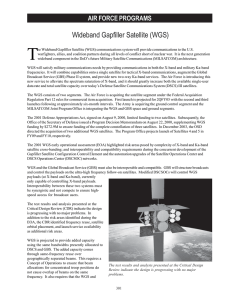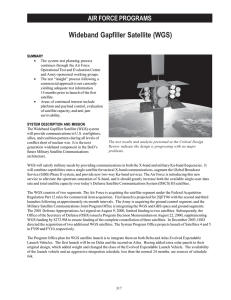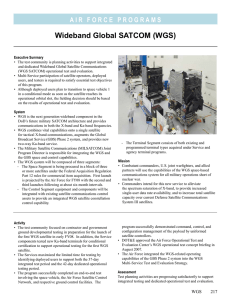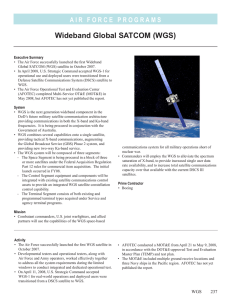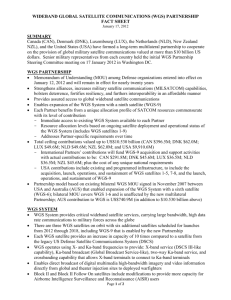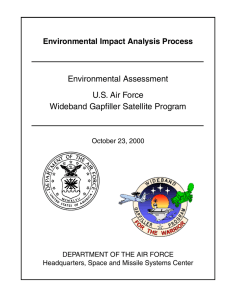FINDING OF NO SIGNIFICANT IMPACT (FONSI) CAPE CANAVERAL AIR STATION, FLORIDA
advertisement
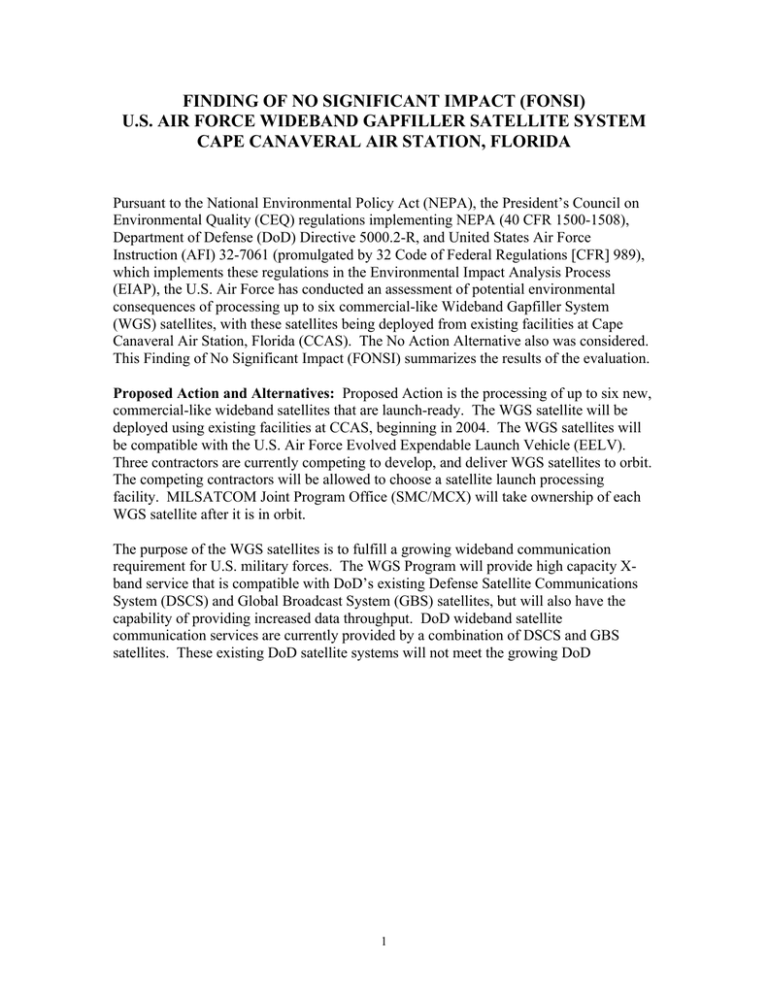
FINDING OF NO SIGNIFICANT IMPACT (FONSI) U.S. AIR FORCE WIDEBAND GAPFILLER SATELLITE SYSTEM CAPE CANAVERAL AIR STATION, FLORIDA Pursuant to the National Environmental Policy Act (NEPA), the President’s Council on Environmental Quality (CEQ) regulations implementing NEPA (40 CFR 1500-1508), Department of Defense (DoD) Directive 5000.2-R, and United States Air Force Instruction (AFI) 32-7061 (promulgated by 32 Code of Federal Regulations [CFR] 989), which implements these regulations in the Environmental Impact Analysis Process (EIAP), the U.S. Air Force has conducted an assessment of potential environmental consequences of processing up to six commercial-like Wideband Gapfiller System (WGS) satellites, with these satellites being deployed from existing facilities at Cape Canaveral Air Station, Florida (CCAS). The No Action Alternative also was considered. This Finding of No Significant Impact (FONSI) summarizes the results of the evaluation. Proposed Action and Alternatives: Proposed Action is the processing of up to six new, commercial-like wideband satellites that are launch-ready. The WGS satellite will be deployed using existing facilities at CCAS, beginning in 2004. The WGS satellites will be compatible with the U.S. Air Force Evolved Expendable Launch Vehicle (EELV). Three contractors are currently competing to develop, and deliver WGS satellites to orbit. The competing contractors will be allowed to choose a satellite launch processing facility. MILSATCOM Joint Program Office (SMC/MCX) will take ownership of each WGS satellite after it is in orbit. The purpose of the WGS satellites is to fulfill a growing wideband communication requirement for U.S. military forces. The WGS Program will provide high capacity Xband service that is compatible with DoD’s existing Defense Satellite Communications System (DSCS) and Global Broadcast System (GBS) satellites, but will also have the capability of providing increased data throughput. DoD wideband satellite communication services are currently provided by a combination of DSCS and GBS satellites. These existing DoD satellite systems will not meet the growing DoD 1 date rate communication requirements in the future. The WGS Program provides an interim solution to assure the DoD’s existing worldwide communication support is maintained until the development and deployment of the Advanced Wideband Satellite System. The WGS Program proposes a “commercial-like” procurement as an option to DoD’s entering into a full development process. The concept of the “commercial-like” WGS satellites recognizes the ability of industry to lead the development of DoD satellite communications technologies. This allows DoD to take advantage of new commercial technologies and manufacturing processes and achieve significant cost savings in system procurement. “Commercial-like” also recognizes that there are unique U.S. military needs that must be considered in developing a military SATCOM system. The WGS Program is a new partnership between DoD and industry to demonstrate how commercial technologies can provide affordable systems to provide satellite communications support to U.S. military operations. The No Action Alternative consists of continuing to rely on existing DoD communication systems (i.e., DSCS and GBS) to support the communications needs of global U.S. military operations. If the WGS Program does not go forward, DoD satellite communications capabilities will be at risk and will not be adequate to meet DoD’s future communication requirements. No other alternatives to the WGS Program have been identified by the SMC/MCX. Anticipated Environmental Effects: The Environmental Assessment (EA) evaluated the environmental impacts of processing of up to six WGS satellites. The potential environmental effects of the Proposed Action and alternative were assessed for the following environmental resource areas: hazardous materials and waste management, radiation, air quality and deorbiting debris. Impacts associated with the EELV launch vehicle were previously assessed in a Final Environmental Impact Statement (EIS) dated April 1998 and in a Supplemental EIS dated March 2000. 2 Processing of the WGS satellites will be conducted in accordance with applicable federal, state and local legislation and regulations, including existing permits. At the end of the operational life of each satellite, remaining fuel will be used to move the satellite to an orbit beyond geosynchronous Earth orbit. As a result, potential impacts related to deorbiting debris would not be significant. The EA determined that the WGS Program will have no impact on hazardous materials and waste management, radiation or air quality. Public Comment Period: A period of public comment was held from October 13 to October 23, 2000. During this time, the EA was available for review in the El Segundo, California, and Broward County, Florida public libraries, and appeared in the Daily Breeze Newspaper of Torrance, California and Florida Today of Melbourne, Florida. Copies of the newspaper clippings reside in the SMC/PA files. A copy of the EA is currently available on the Los Angeles Air Force Base web site. During the public comment period, no comments were received. Conclusion: Based on the EA, which is herein incorporated by reference, it is concluded that the Proposed Action will not result in significant environmental impacts or cause significant cumulative impacts in association with other programs. An EIS is not required. This FONSI, with the supporting EA, fulfills the requirements of NEPA, CEQ regulations, and AFI 32-7061. Point of contact for this document is Captain Sonny Kagan, Military Satellite Communications Joint Program Office, telephone (310) 3364868. The final FONSI and its associated EA is stored in the Wideband Gapfiller Program Office program files, MILSATCOM Joint Program Office (SMC/MCX), 2420 Vela Way, Suite 1467-A8, Los Angeles Air Force Base, California 90245-4659 as well as the SMC/AXFV web site at http://ax.laafb.af.mil/axf. Mitigation: The processing of up to six new commercial-like WGS satellites will occur within established private and military systems where policies and procedures are in place for compliance with local, state and federal regulations. As a result, existing measures are utilized to control potential impacts associated with hazardous materials and 3

